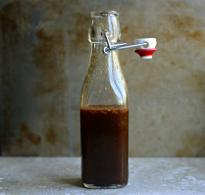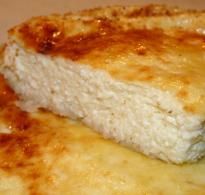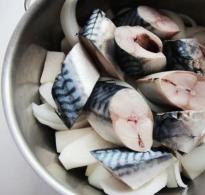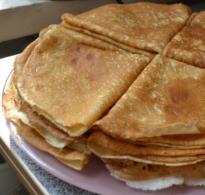Italian ciabatta. Ciabatta: a recipe for baking bread in the oven with step by step instructions
It has long been loved by the Russians. It is so convenient to cook grilled sandwiches, croutons and croutons for serving with various sauces from it! If you are wondering how to prepare ciabatta at home, then read this article. We will share with you the secrets of its preparation, as well as describe some of the most popular recipes.
at home
If you decide to cook this fragrant Italian bread according to all the rules of culinary art, then be patient and approach the cooking process as seriously as possible. Cooking ciabatta at home:
- Mix 450 grams of flour with one teaspoon of salt and dry yeast (ten grams). To better combine the dry ingredients, sift them through a sieve.
- Pour 350 grams of water into a bowl and mix it with flour.
- Cover the dough with a towel and leave to ferment for 12 hours. It will be better if you put the dough in the evening. In this case, for breakfast you can serve fresh fragrant bread straight from the oven.
- Dust the work surface with flour and place the dough on it. Be careful - it will be quite sticky and runny.
- Wrap the edges of the dough towards the center so that it resembles a loaf. Repeat the procedure several times. As soon as the dough acquires a dense structure, divide it into two equal parts.
- Gently stretch the blanks with your hands so that each one acquires a rectangular shape (10 by 20 cm).
- Put the future bread on a waffle towel, thickly sprinkled with flour, cover with a second towel and let stand for one hour.
- Preheat the oven, line a baking sheet with parchment paper and carefully place the ciabatta on it. To create steam in the oven, spray water into it with a spray bottle.
After half an hour, when the bread is sufficiently browned, turn off the oven and call your family to the table.

Homemade ciabatta bread (with filling)
The preparation of this bread will not cause difficulties for an experienced hostess. However, you should pay attention to some of the nuances of this recipe. So, how is real Italian ciabatta made at home? The process is:
- For dough, mix 100 grams of flour, one bag of yeast, 200 ml of water and 30 grams of sugar.
- When the base is ready, leave it to rise for 12 hours (under a towel) at room temperature.
- When the time is right, pour 450 ml of water into the dough, add 15 grams of salt and 900 grams of flour. Knead the dough, do not forget to add a little vegetable oil to it.
- While the dough is rising, prepare the filling. It can be fried onions, dry herbs (for example, oregano or basil), capers and sun-dried tomatoes, olives.
- Divide the finished dough into three equal parts and knead each, adding the filling. Form three loaves and let them stand under the cloth for about an hour.
- Bake the bread in the preheated oven for about ten minutes.

Ciabatta with cheese
Making ciabatta at home can be a creative process for you. Try to make bread with the addition of cheese - and your loved ones will definitely appreciate the new dish. For this:
- Mix in a deep bowl 450 grams of flour, 300 ml of water, half a teaspoon of salt and a bag of yeast. Leave the dough (as usual) for 12 hours.
- 50 grams (you can take Adyghe or cheese), cut into cubes or knead into crumbs with your hands.
- Sprinkle the table with flour, put the dough on it, and evenly sprinkle it with cheese on top. Wrap the edges of the workpiece to the middle, cut it in half, cover with a thick cloth and leave it alone for an hour.
- When the ciabatta has risen, carefully transfer it to a parchment-lined baking sheet. Pour some water into another baking sheet and put it in the preheated oven as well.
After half an hour, the bread will acquire a golden crust and will be ready. Serve it to the table with fragrant sauces or make it the basis for sandwiches.

Ciabatta with and garlic
This recipe was invented specifically for those cases when tasty and fragrant bread was left out of work and became stale. You can fix the current situation with the help of small tricks. Spicy ciabatta at home is prepared as follows:
- Cut the dried loaf with a knife from above, without touching the base, along and several times across.
- spread evenly over the entire surface of the bread.
- Chop the parsley, rosemary and oregano. Pass the garlic through a press, combine it with herbs, ground pepper and olive oil.
- Rub the mixture on the inside and outside of the ciabatta.
- Crumple up a piece of parchment that fits the size with your hands, soak it in water and wrap the bread with it. In this form, ciabatta should stay in the oven for about ten minutes.
Conclusion
As you can see, Italian ciabatta is not so difficult to prepare at home. The main thing is to choose your favorite recipe and get down to business.
Today we have an unprecedented event - a recipe for shamelessly white bread - Italian ciabatta! But as an example of working with wet dough and kneading it in an Ankarsrum kneader, it is perfect. In addition, admit, despite the ardent love for whole grain healthy bread, past ciabatta (this is the correct pronunciation, I was not mistaken) is still difficult to pass, this is not bread, but magic! The dough is silky, stretches with transparent films, puffs up with bubbles, fluid and elastic at the same time, the bread is porous and spongy, but not as pliable as a featherbed. At the same time, the taste of bread is also surprising: there is no butter or sugar in it, but it is so soft and creamy, and how beautiful it is!
Many people are afraid to bake ciabatta because the recipe seems very complicated, working with it is scary, they can’t believe that they will get the desired “holes” in the bread. In fact, everything is not so difficult, you just need to know how to do it right, and then everything will work out. Shall we start?
For steam you need:
150 gr. wheat white flour;
150 gr. water;
10 gr. rye or wheat tarter.
I baked two options at once, one on a thick Italian sourdough (disposal of leftovers) and the second on a 100% sourdough, I will dwell on the second variant in more detail. Dissolve the starter in water, add flour and mix, cover with cling film and leave overnight. In the morning, we should get a fluffy sourdough with lots of bubbles.
For test:
Whole sourdough (dough);
315 gr. white wheat flour;
215 gr. water (warm, about 30 degrees);
10 gr. salt;
½ tsp bio-yeast + a pinch of sugar.
If you are against yeast to the bone, do not take yeast, and without it everything will work out (but longer), but initially the recipe suggests the presence of these. The dough for this recipe turns out to be quite wet, so to make it convenient to work with, you need to know a few tricks.
batch.I kneaded with a stationary scraper and hook, most often I use the hook.
Weigh all the ingredients in separate containers, pour some of the water (50-70 grams) into a cup, add a small pinch of sugar, pour in the yeast, mix and set aside. After 15 minutes, a small yeast cap should appear in the cup.
This cup of water is strategic, if you're using yeast that doesn't need to be activated, still discard some water (no yeast) to add as you knead, this will help you get a firmer, less runny dough.
Pour the rest of the water into the mixing bowl, dissolve the leaven, sift the flour and turn on the mixer at minimum speed for a couple of minutes. The contents of the bowl should first turn into a lumpy mass, then, as the flour is mixed and moistened, into a sticky dough. Turn off the mixer, cover the bowl with a wide bag so that the dough does not dry out and leave for 20 minutes.
After 20 minutes, add half the yeast water and salt (do not mix yeast water with salt, salt inhibits yeast), start kneading on speed 3. When the added water is completely combined with the dough, add the rest of the water (with or without yeast) and continue kneading for another 7 minutes, maximum 10.
The finished dough will be silky and fluid, if left alone for a few minutes, it will immediately spread along the bottom of the bowl.
First remove the scraper from the dough mixer, then the hook, and then, using a manual scraper, remove the dough and transfer it to a bowl greased with vegetable oil. Fold the dough, pull into a ball and lay to rise. The dough will begin to spread out almost immediately.
Fermentation 2.5-3 hours, during this time it is desirable to fold the dough at least three times. But if you notice that the dough “weakens” and becomes more fluid during fermentation, fold it every half hour. By the end of fermentation, it should become lush and bubbles should appear inside it.
Dust your work surface well with flour and turn out the dough. Sprinkle it with flour and carefully stretch it into a rectangle. I worked with the dough on a floured towel, on which I sometimes spread the dough.
Divide the dough into two parts with a scraper, form blanks, wrapping the dough with an overlap. I also rolled up the long ends of the dough to fit under my hat. If necessary, transfer the workpieces to a linen towel rubbed with flour (if not molded on it).
Make towel edges around the blanks so that the blanks do not stick together and do not spread, provide support to the extreme sides, sprinkle the ciabattas with flour. Proofing time 1.5 hours. During this time, I checked the blanks a couple of times to see if they stuck to the towel and sprinkled the problem areas with flour.
Preheat the oven to 230-240 degrees with stone, I warmed for 40 minutes, as usual. If you are planning to bake under a hood or in a roaster, and your “bell” has thick walls, then, like the duckling, you need to heat it together with the oven, that is, heat it up in advance. Carefully transfer the blanks or one blank onto the parchment (I baked in turn, so I shifted one blank) and turn over to the other side so that the bubbles in the dough are evenly distributed (and so they will be concentrated on the top of the bread). It is important here not to stretch the workpiece, you need to take it from the long sides so that, on the contrary, it folds like an “accordion”, and carefully level it on the parchment. The first 15 minutes of baking with steam or under a hood, after 15 minutes remove the steam without lowering the temperature, bake for another 15 minutes.
Wait until it cools down to at least warm, and cut, cut, do not be sorry! This is a wonderful bread)) Try to bake it, it's a great pleasure!
In full screen
I have always loved ciabatta bread. Probably due to the fact that it is similar to one kind of bread that I ate as a child. So I became interested in cooking it. Just like white bread, ciabata turned out far from the first time. Oddly enough, there are a lot of ciabatta recipes on the Internet. And everyone is different. They say that you need to use a special mixture. I was skeptical about this and continued to search. And suddenly it dawned on me. And who, if not Italians, knows how to cook ciabatta? And I began to collect information bit by bit.
In full screen
That's what I "dug up". Firstly, the dough for ciabatta is much more "thin" than for bread. Secondly, ciabatta dough must rise for at least 18 hours. Thirdly, the dough is not kneaded, but simply mixed. Before the second proofing, he just needs to be shaped. Fourth, during the second proofing, the dough is covered with a towel and left to rise for another 2 hours. Fifthly, the dough should be parted for the second time already on the pie sheet (the pie sheet heats up faster). Sixth, the baking temperature is 220 degrees Celsius and above, the baking time is 35-40 minutes. The color of the rind should be grey-brown and rather dark. Seventh, be sure to cool on a wire rack until completely cool.
In full screen
But! I won't wait that long and will make a "quick" version When I read about the easy version I was very surprised! Try it! In truth, they say that everything ingenious is simple! (I just blew my mind when with such a simple option I got a VERY good result)
In full screen

So - Ciabata - without kneading the dough. Oddly enough, I found the recipe I liked the most on Youtube. I just typed Ciabatta and saw a wonderful video of two kids making bread. Of course, I was amazed that they did not knead the dough at all, but simply mixed it in containers. I will make a reservation right away. I don't like it when the bread is too airy, so I have ciabatta the way I like it. How to achieve this - see the explanations for proofing the dough.
In full screen

In full screen

Mix most of the flour and water. Sprinkle salt and the rest of the flour and stir with a whisk, fork or spatula for a couple of minutes.
In full screen

In full screen

The ambient temperature is important here. In general, it is supposed to stand at a temperature of 25-30 degrees. But, since I like the bubbles to be larger than in regular white bread, but not very big, I simply leave at room temperature. Alternatively, you can preheat the oven to 25-30 degrees (three minutes on minimum heat) and put the container with the dough inside. Thus, you will get rid of drafts. After proofing, remove the film from the mold. Sprinkle the table with flour. Pry the dough from the edges with a spatula, as it were, "cut off" from the surface of the mold until the dough separates from the mold and falls on the table, trying not to put too much pressure on the dough. Divide the dough into two with a spatula or knife. Place baking paper on a baking sheet. Sprinkle with flour.
In full screen

Then proceed very carefully, trying not to wrinkle the dough. Gently spread the dough onto the flour. Form an oval from the dough. Don't try to be too straight. Remember that air bubbles that have already formed do not come out of the dough. Dust the top of the ciabatta fairly liberally with flour.
In full screen

The famous Italian ciabatta can easily be cooked at home, no worse than the real one, which the Italians love so much and cannot imagine life without it. So, today we have ciabatta at home in the oven: a recipe with a photo - everything ingenious is simple!
Ciabatta... Just listen to the name. As if the Mediterranean Sea gently sways at your feet, and you are sitting in a cozy restaurant on the shore with a glass of good wine. And it is strange to find out that such a bright dish, as if breathing old Italy, is actually very young and came to us not from the notebooks of Italian housewives, but as a successful result of the experiments of a very specific person - Arnaldo Cavallari. Moreover, the name caressing the sound in the original language means ... slippers.
But let's not rush into disappointment. Who said that a new recipe cannot be good, wonderful, excellent? A crispy thin crust that hides an elastic crumb with huge pores, a delicate noble aroma - the result of a long maturation of the dough - and a special taste that is difficult to describe, but can only be felt ... Ciabatta is truly an amazing bread. Born centuries later than classic Italian dishes, it blends so harmoniously into the culinary traditions of the region, as if it had always been present there.
How ciabatta is prepared
The original recipe, of course, is known to the inventor. Incidentally, Cavallari has copyrighted it and registered the title. If you are in Italy, in the town of Bottriga, you can visit Arnaldo's master class and see with your own eyes the birth of a real ciabatta (and remember the technology, of course).
Classic ciabatta
water - 330 g
salt - a teaspoon
dry yeast - an eighth of a teaspoon
high protein flour - 250 g
semolina - 150 g
olive oil - 1 teaspoon
The dough is kneaded with a mixer at high speed for 10-20 minutes (this is an important part of the process), left to ferment in a warm place, covered with a film. Fermentation should go on for 10-12 hours, and readiness is determined by the moment of its maximum rise. Once the level of the dough has started to drop, the ciabatta must be prepared for baking, otherwise the dough will ferment and the bread will fail.
From the container in which the dough was proofed, it is transferred to a table well sprinkled with flour, and even better - with semolina. They are divided into two parts (the dough is not kneaded, they work carefully with it as it is!). After a half-hour rest, the blanks are transferred to a baking sheet with parchment and placed in a hot oven.
Humidity must be maintained inside the oven so that the crust dries slowly and remains thin.
Bread is baked for 30-35 minutes, and the finished ciabatta, when tapped, produces a characteristic dull sound.
The fermented dough gives the bread a noble, slightly sour “homemade” taste and aroma.
By the way, ours are just perfect for this wonderful Italian bread. Great lunch in a mix of styles!
Quick ciabatta at home, a simple recipe

- 225 g of water;
- salt - 1.25 tsp;
- dry yeast - 1 tsp
All ingredients are poured into the bowl of the combine or mixed in a bowl convenient for using the mixer. Knead the dough at high speed for about 20 minutes. Intensive kneading greatly changes the structure of the dough. If at first it turns out to be liquid, then by the end of the batch it becomes thick and very elastic, it literally wraps around the blades and gathers towards the center of the bowl.
The dough is proofed in a warm place under the film. The duration of fermentation depends on the yeast - the finished dough should become liquid again and begin to bubble strongly.
Further, the baking procedure is the same as for the classic ciabatta.
Important little things:
- The blanks are laid out on a heated baking sheet.
- To maintain the desired humidity, a container of water is placed at the bottom of the oven. The sooner the water is removed, the thicker the crust will be.
- Semolina is the crushed kernels of wheat grains. It differs from semolina in that it is made from durum wheat. If there is no semolina, you can use semolina, although this will be a small deviation from the original recipe.
- Overexposed dough does not rise well in the oven. When preparing bread according to the classic recipe, do not miss the moment of the highest rise.
- Do not shorten the kneading time - this will significantly reduce the quality of the finished bread.
High protein flour (strong flour) is 13% or more. - There is little yeast in the classic ciabatta recipe. This is not a mistake, but an account of the fact that the dough will ferment for a long time.
What to serve with ciabatta
You can just use water. The bread is so tasty that it doesn't need any additives. But it gained popularity in the world as the basis for sandwiches.
And, of course, ciabatta is suitable for hot first courses.
Quick ciabatta with plain flour

And more about how to cook ciabatta at home in the oven - the use of "strong" flour is an important feature in the recipe for this bread. But if you did not find it on sale, you can cook ciabatta with ordinary wheat flour. In this case, the pulp will be slightly less elastic, and the pores may turn out to be smaller, but if you repeat the entire technology exactly (long kneading with a mixer, proofing the dough until a large number of bubbles appear, careful handling of the workpieces and baking in a well-heated oven to quickly form a crust ), you will still get ciabatta - tall bread with large pores and a crispy crust.
- 225 g of water;
- 300 g flour (with a protein content of at least 13%);
- salt - 1.25 tsp;
- dry yeast - 1 tsp
Cooking homemade ciabatta
Pour the ingredients into the mixer bowl. 
Turn on the dough kneading mode at maximum speed. At first, the dough will be liquid. 
Knead the dough at maximum speed for at least 10 minutes. After that, it will become very viscous.

Leave to part under the film until abundant bubbles appear. Transfer to a surface sprinkled with a mixture of flour and semolina (or semolina).

Form oblong loaves without kneading the dough (sprinkle semolina on all sides), leave them for 30 minutes and transfer to a hot baking sheet. Bake in a preheated oven at 250-300 C for 5 minutes, then reduce the temperature to 200. Place a plate of water in the oven. Until ready. Cheese, olives or are perfect for such a bread.
So, we have already mastered ciabatta at home in the oven, the recipe with a photo will help you bake this delicious bread and delight your household! Bon appetit!
How to cook ciabatta? Step by step recipe
Ciabatta can be served both as an addition to any other dish, and as a full-fledged dish with filling. There are many variations of this dish. Most often, Italian bread is combined with meat, cheeses, vegetables and sauces.
We suggest you try the fragrant ciabatta bun, following the recipe with the photo step by step. The recipe for a delicious and simple ciabatta will allow you to knead the dough at home to prepare the desired consistency and bake a bun with a spicy aroma and appetizing look.
Main Ingredients:
- 800 g of wheat flour (350 grams for sourdough, 450 grams for dough);
- half a liter of water (180 milliliters for sourdough, 340 milliliters for dough);
- 1 package of yeast - 1 package (1/2 teaspoon for sourdough, 10 grams for dough);
- 50 g olive oil;
- spices.
Step by step cooking recipe:
- Before you start cooking, you need to divide the flour, yeast and water in order to knead the dough and make a starter. 800 grams of flour is divided into 350 grams and 450 grams, which will be used to prepare the sourdough and the dough itself, respectively. Water also needs to be divided: 170 milliliters are poured for sourdough, the rest is left in order to knead the dough. We do the same with yeast. We leave half a teaspoon for making sourdough and about 10 grams for kneading the dough. The sourdough must have an airy structure.
- We mix flour, water and yeast in the given proportions using a mixer and a special nozzle for making dough. Mix the ingredients slowly and for a long time in a deep bowl. The flour must be well sifted, and the water must be heated.
- The prepared mixture should ferment for about a day in a warm and dark place, as well as under a film.
- When the starter is infused, you can knead the dough. To do this, take the remaining flour, yeast and salt and mix. Pour vegetable oil and sourdough into the mixed ingredients, and then add warm water. At low speed, mix all the ingredients with a mixer into a homogeneous mass for ten minutes. The consistency of the dough should be slightly watery, but elastic and tender. Leave the resulting mass in a large deep bowl until it rises.
- Later, the dough must be kneaded back and transferred to the same bowl for two hours, while adding the desired filling. For filling ingredients, you can use pieces of vegetables, spices and spices, cheese, pieces of meat, olives and even nuts.
- After that, the dough should be laid out on a floured table and formed into loaves (you can make small buns or one large loaf). You no longer need to knead the dough, but you can form the shape by pulling it vertically or horizontally until it reaches a flattened shape.
- Ready-made bread rolls can also be left for an hour, sprinkled with flour.
- The oven should be heated to the maximum temperature and make sure that the environment in it is moist (you can use a container of water or a spray bottle).
- At 220 degrees, bake bread for about twenty minutes.
The finished dish is porous and soft!
Rye ciabatta. Sourdough Recipe
Cooking ciabatta at home is not difficult, but you must follow all the rules exactly with the recipe. Below we will present a detailed recipe for Italian rye sourdough bread, which will allow you to cook this wonderful dish at home.
To bake rye bread, you need to use not only wheat, but also rye flour. The rest of the baking recipe is similar to the classic variation. In rye ciabatta, add the same amount of wheat and rye flour, salt, sugar, yeast, warm water, vegetable oil, your favorite seeds for taste, and follow the classic recipe, keeping the proportions.
To give the bun a spicy and rich taste, aromatic spices and other ingredients are used to add to the dough. Ciabatta can be cooked with olives, olives, herbs, onions or garlic, peppers or tomatoes, as well as salmon and even chicken.
There are also many recipes for making Italian bread without yeast - yeast-free ciabatta. Or you can safely take up cooking ciabatta with fresh yeast or pressed live yeast. The main nuance of cooking is the willingness to improvise with the filling, but full compliance with the given recipe.

Dark ciabatta made from rye flour can be cooked not only in the oven or bread machine, but also on the stone. A recipe with a photo or video can be found on the Internet and, following step-by-step instructions, prepare delicious bread the same as true Italians do.
Italian bread with cheese. Recipe with photo
A step-by-step recipe for Italian ciabatta with cheese at home will allow you to bake a real original dish. A recipe with photos and videos from Yulia Vysotskaya will help you knead the dough correctly in order to bake such popular bread at home. Preparing this variation of ciabatta with cheese is quick and easy! The recipe for Italian bread resembles the standard.
Main Ingredients:
- 250 ml of warm water;
- 4 g yeast;
- 250 g flour;
- a pinch of salt and sugar;
- cheese for stuffing.

Step by step cooking recipe:
- Mix flour, yeast, salt and sugar in warm water to knead the dough.
- Using a mixer with a whisk to prepare the dough, knead the ingredients in a deep bowl for about ten minutes at high speed.
- The dough should be homogeneous and stick off the bowl (when stirring, you can add flour).
- We leave the resulting mass in a deep bowl, covered with a towel, until it rises (from two to three hours). You can add the desired filling - in our case, cheese.
- Cheese for the filling can be grated or cut into cubes.
- The dough must be laid out on a table sprinkled with flour and give it the desired shape of loaves.
- Future loaves laid out on parchment can be left for forty minutes, also covered with a towel.
- The oven is heated to maximum temperature. At 220 degrees, you need to bake bread for about forty minutes, not forgetting to “splash” the oven with water about two times.
- The finished dish should be cooled, covered with a towel so that it turns out soft and porous.
If you want to change the ingredients, you can safely add not only cheese, but also spices, olives, seeds to the dough. By diversifying the usual recipes, you can surprise your guests with new variations of this simple dish!
ciabatta recipe at home
Making traditional bread from Italy at home is not very difficult. Products for ciabatta can be easily found in the supermarket, and most have them at home. With the help of step-by-step instructions with photos, you can make homemade ciabatta bread. The recipe is simple and quick to prepare.
We will tell you how to bake ciabatta in a bread machine. The recipe for bread in a bread machine is very simple and will allow even novice cooks to please guests with fresh and warm bread, which is suitable for a hearty breakfast!

To prepare a flour product, use the instructions for ciabatta in a bread machine with a photo or step by step. For baking, you will need a standard set of ingredients from classic recipes, as well as garlic and spices for the filling.
Main Ingredients:
- 250 g wheat flour;
- 150 ml of water;
- 4 g dry yeast;
- 1 tsp salt;
- 1 st. l. vegetable oil;
- 2 tsp spices (you can take a mixture of "Italian herbs");
- 1 tsp dry minced garlic.
Panasonic ciabatta step by step recipe:
- To knead the dough in a bread machine, mix flour, yeast, salt, garlic and spices.7
- Fill everything with the right amount of water.
- Turn on the test kneading function.
- The bread machine should work for about two hours, after which the resulting liquid mass must be removed from the bowl and put on the table.
- We form loaves from the dough and leave for thirty minutes.
- On the main mode of the bread machine, bake the dough until golden brown (about half an hour).
- Taking the bread out of the oven, they are covered with a towel for five to ten minutes.
- The finished bun should be porous and soft.
In order for Italian buns to succeed, you can use a bread machine of any company. For example, pastries can be baked in a Panasonic 2501 (Panasonic), Redmond, Mulineks or Kenwood bread machine. Recipes for ciabatta in a slow cooker with photos from Italian chefs will help you recreate the taste of a real Italian meal made from rye flour.
The Italian ciabatta recipe from Jamie Oliver, Yulia Vysotskaya, Richard Bertine and other chefs will give you the opportunity to replace your usual pizza, bun or cheese sandwiches with something completely new! The Ciabatta Sandwich Recipe allows you to use Italian bread for everyday breakfasts and dinners!
Bon appetit!






